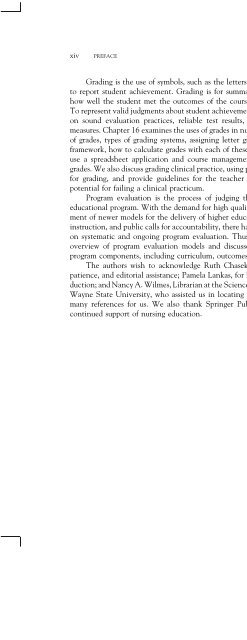Evaluation and testing in nursing education - Springer Publishing
Evaluation and testing in nursing education - Springer Publishing
Evaluation and testing in nursing education - Springer Publishing
Create successful ePaper yourself
Turn your PDF publications into a flip-book with our unique Google optimized e-Paper software.
xiv<br />
PREFACE<br />
Grad<strong>in</strong>g is the use of symbols, such as the letters A through F or pass-fail,<br />
to report student achievement. Grad<strong>in</strong>g is for summative purposes, <strong>in</strong>dicat<strong>in</strong>g<br />
how well the student met the outcomes of the course <strong>and</strong> cl<strong>in</strong>ical practicum.<br />
To represent valid judgments about student achievement, grades should be based<br />
on sound evaluation practices, reliable test results, <strong>and</strong> multiple evaluation<br />
measures. Chapter 16 exam<strong>in</strong>es the uses of grades <strong>in</strong> nurs<strong>in</strong>g programs, criticisms<br />
of grades, types of grad<strong>in</strong>g systems, assign<strong>in</strong>g letter grades, select<strong>in</strong>g a grad<strong>in</strong>g<br />
framework, how to calculate grades with each of these frameworks, <strong>and</strong> how to<br />
use a spreadsheet application <strong>and</strong> course management system for calculat<strong>in</strong>g<br />
grades. We also discuss grad<strong>in</strong>g cl<strong>in</strong>ical practice, us<strong>in</strong>g pass-fail <strong>and</strong> other systems<br />
for grad<strong>in</strong>g, <strong>and</strong> provide guidel<strong>in</strong>es for the teacher when students have the<br />
potential for fail<strong>in</strong>g a cl<strong>in</strong>ical practicum.<br />
Program evaluation is the process of judg<strong>in</strong>g the worth or value of an<br />
<strong>education</strong>al program. With the dem<strong>and</strong> for high quality programs, the development<br />
of newer models for the delivery of higher <strong>education</strong>, such as Web-based<br />
<strong>in</strong>struction, <strong>and</strong> public calls for accountability, there has been a greater emphasis<br />
on systematic <strong>and</strong> ongo<strong>in</strong>g program evaluation. Thus, chapter 17 presents an<br />
overview of program evaluation models <strong>and</strong> discusses evaluation of selected<br />
program components, <strong>in</strong>clud<strong>in</strong>g curriculum, outcomes, <strong>and</strong> teach<strong>in</strong>g.<br />
The authors wish to acknowledge Ruth Chasek for her encouragement,<br />
patience, <strong>and</strong> editorial assistance; Pamela Lankas, for her assistance dur<strong>in</strong>g production;<br />
<strong>and</strong> Nancy A. Wilmes, Librarian at the Science <strong>and</strong> Eng<strong>in</strong>eer<strong>in</strong>g Library,<br />
Wayne State University, who assisted us <strong>in</strong> locat<strong>in</strong>g <strong>in</strong>formation <strong>and</strong> checked<br />
many references for us. We also thank Spr<strong>in</strong>ger Publish<strong>in</strong>g Company for its<br />
cont<strong>in</strong>ued support of nurs<strong>in</strong>g <strong>education</strong>.<br />
Marilyn H. Oermann<br />
Kathleen B. Gaberson

















